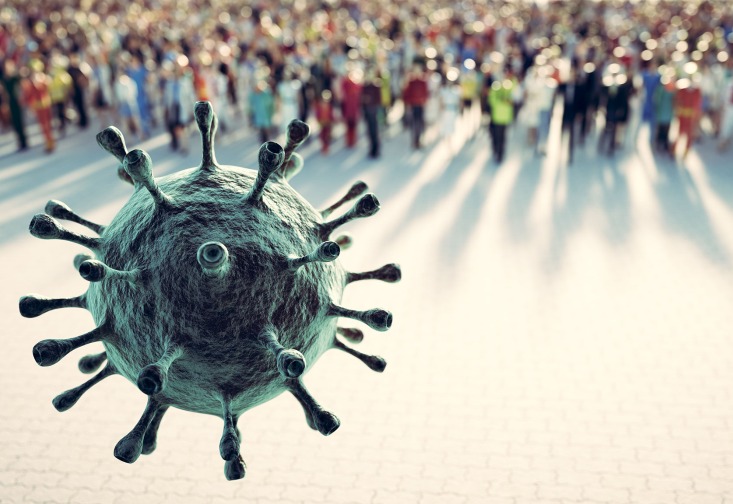TAMPA, Fla. – A year after USF created the Pandemic Response Research Network and funded three rounds of seed grants to kickstart research into the challenges presented by the pandemic, research and innovations produced in the unprecedented effort continue to take shape. Recently, several teams shared updates on their projects and how they are leveraging their ideas to delve into the mysteries of this pandemic, but also address future viral outbreaks.
Among the projects highlighted were several supported by the Florida High Tech Corridor, which contributed $300,000 to bring the total investment in USF’s seed-grant projects to more than $1 million. The Corridor specifically supported 16 projects with new technology that through partnerships with private industry can be brought to market quickly. Corridor CEO Paul Sohl said the rapid progress made in the projects belies the false notion that university research takes too long to be effective.
“What you are doing right now is relevant to problems across the world,” Sohl told the resachers. “You are making an impact on folks who are suffering.”
Here are recaps of some of the USF COVID-19 research projects.
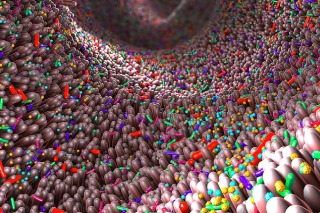
COVID-19 Animal Model Resource Development for Microbiome & Intervention Studies
Principal Investigators: Dr. Christian Brechot and Dr. Shyam Mohapatra, Morsani College of Medicine
Industry Partners: Persephone Biosciences, San Diego; Venn Therapeutics and Ibis Therapeutics, Tampa
This project is developing preclinical models for use in Biosafety Level 3 and Animal
Biological Safety Level 3 facilities that would allow researchers to work on infectious
agents with the highest level of safety and security standards and practices. Led
by Dr. Brechot, an internationally-known virologist who at USF has focused on the role of the gut microbiome in fighting disease, and
Dr. Mohapatra, a USF Distinguished Professor who invents new nano-scale therapies
for a wide range of diseases, the high-level labs and new preclinical model will allow
scientists to pursue translational research on new vaccines and therapies.
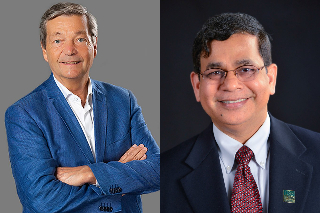
Dr. Christian Brechot and Dr. Shyam Mohapatra
The preclinical model the research ream developed uses a hepatitis virus which in mice develops the same symptoms of a SARS-CoV-2 infection shown in humans. Some mice have slight body temperature increases, some have body weight decline with similar infiltration and inflammation in the lungs, the researchers said. The team is also focused on developing a model for long COVID-19 where symptoms persist for weeks and months after the virus should have been cleared from the body.
“Our models have been developed, now we can use it to test vaccines, treatments, and prophylactic methods,” Dr. Mohapatra said.
Two papers and several patent disclosures have already emerged from their work.
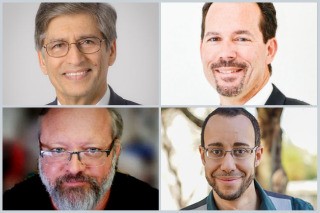
Dr. Yogi Goswami; Dr. Stephen Saddow; Mark Weston, AIA; and Dr. Michael Celestin.
Plasmonic-PECO integrated with mask/respirator/ventilator for protection against COVID-19
Principal Investigator: Dr. Yogi Goswami, College of Engineering.
Co-PIs: Dr. Stephen Saddow, College of Engineering; Mark Weston, AIA, School of Architecture and Community Design, College of the Arts; Dr. Michael Celestin, Senior Research Engineer.
USF Distinguished Professor of Engineering Yogi Goswami’s air purifying technology gave rise to his invention, Molekule, an air purification device capable of destroying a wide range of viruses, bacteria, spores and hazardous organic chemicals. Last year, Molekule met the FDA performance standards set for effectiveness against SARS-CoV-2 in its Air, Air Mini and Air Pro RX devices. Now, Dr. Goswami is taking an advanced version of the technology to build better ventilators and safer masks for healthcare workers.
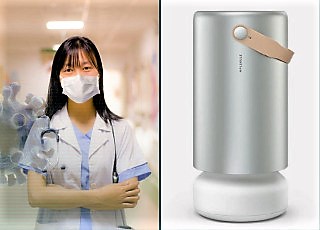
The underlying technology of the Molekule air purifier is being built upon to create more effective safety masks for healthcare providers and other professions needing purified air to work safely.
Molekule’s proprietary photo-electrochemical oxidation (PECO) technology uses UVA light to destroy viruses. Dr. Goswami has advanced his original invention, naming it Advancement Plasmonic PECO. The patent-pending technology is small enough that it can be incorporated into ventilators and face masks.
“We know now that COVID infections are primarily airborne,” Dr. Goswami said. “So, masks are essential in this pandemic, in fact it might be something we need for a long, long time.”
Dr. Goswami said the new masks designs include the ability to purify the air as the wearer is breathing in, and then purify the air the wearer exhales. “It protects the wearer, and others around the wearer, which is what hospitals require,” he said.
Dr. Goswami is collaborating with USF School of Architecture and Community Design Associate Professor Mark Weston, an expert in design, and USF Electrical Engineering Professor Stephen Saddow to create a mask design and accompanying power source.
“Just because we have a scientific advancement in PECO technology, doesn’t mean we will have a commercially successful device unless we have a design which is good for utility, comfort and aesthetics,” Dr. Goswami said. “That’s why we formed this team which includes scientists, engineers as well as professionals in design.”
Weston said one of the problems with masks is in being able to hear the wearer speaking clearly, so the new mask has been equipped with a clear window and microphone, along with valves that ensure air is moving in the proper direction in and out of the mask. “The purpose of industrial design isn’t just making a pretty thing, it also improves the functionality of the device,” he said.
In addition to being useful in protecting the wearer against viruses, Dr. Goswami said the mask also could be used to protect people in heavily polluted areas of the world or in emergencies that cause breathing problems, such as wildfires.
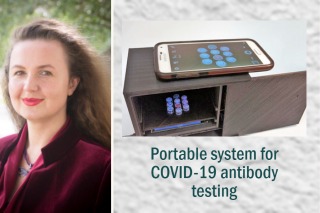
Dr. Anna Pyayt
Portable system for COVID-19 antibody testing based on Mobile ELISA, Deep Learning and AI
Principal Investigator: Dr. Anna Pyayt, College of Engineering.
Pharmaceutical and virology experts say it’s highly likely that people who have received the COVID-19 vaccine will need to get a booster in the future to ensure their antibodies are at the proper levels to fight the virus. But what remains uncertain is when will be the best time to receive a booster shot, and how people will know when to get one. USF College of Engineering Associate Professor Anna Pyayt believes that a simple, portable device can answer those questions.
She has developed a small, inexpensive and rapid system that can measure antibodies without creating a time-consuming or costly process that may not be covered by insurance. Also, the current antibody tests only detect whether there are antibodies present or not, but doesn’t tell people anything about the level of antibodies, she said. Overstimulation of the immune system of a person who still have protective levels of COVID-19 antibodies present can be as undesirable as having too few antibodies, she said.
For several years, Dr. Pyayt has worked in developing medical testing devices that can be integrated with a cell phone to provide a simple point-of-care tool. The project builds upon the enzyme-linked immunosorbent assay (ELISA) technology, which has existed since the early 1970s, which detects the presence of specific proteins and accurately measures them. ELISA is a frequently used diagnostic tool, but Dr. Pyayt has taken the technology further to adapt it to use with a cell phone to create an easy-access testing system.
“We want to determine if you still have enough antibodies for your freedom and safety,” she said, adding the test could be easily administered at walk-in clinics or pharmacies.
COVID-19 Economic Recovery Markers from Satellite Imagery for City-Scale Decisions
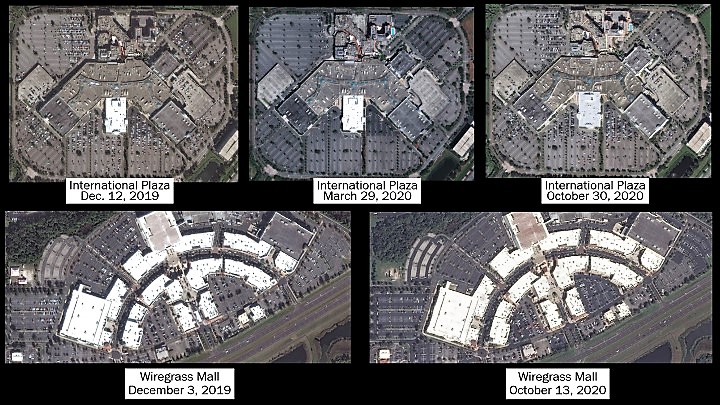
Satellite imagery shows the difference in traffic at area malls before and during the COVID-19 pandemic. Satellite imagery © 2021 Maxar Technologies.
Principal Investigator: Dr. Sudeep Sarkar, College of Engineering.
Co-PIs: Dr. Barnali Dixon, School of Geoscience, USF College of Arts and Sciences; Dr. Zsolt Katona, University of California Berkeley; Dr. Mauricio Pamplona Segundo, USF College of Engineering; Dr. Panos Patatoukas, University of California Berkeley.
Industry Partner: Maxar Technologies, Westminster, CO.
A transdisciplinary team from USF, the University of California Berkeley, and Colorado-based satellite company Maxar Technologies, is developing a new artificial intelligence-enabled system that uses satellite imagery to document and analyze the effects of travel bans and shutdown orders on the local economy quickly and economically, from a single source.
The project develops city-scale economic trend forecasts based on satellite images taken at regular intervals and augmented with information from other sources such as community mobility data, flight tracker data, and railway tracking data said Distinguished University Professor Sudeep Sarkar, co-director of USF’s Institute for Artificial Intelligence (AI+X). For example, if city officials want to know how effective a shutdown order is or if the economic recovery is going as planned, the new system will capture vehicle traffic and analyze images of parking lots of local malls and restaurants to determine how use has changed over time.
In October, the project won prizes from the European Space Agency for the best weekly and monthly ideas for their script that tracked airplanes in the air and on the ground. In the final phase of the competition, the developed algorithms had to be scaled up and process data across Europe. The solution had to be integrated into the Rapid Action on Coronavirus and EO (RACE) portal.
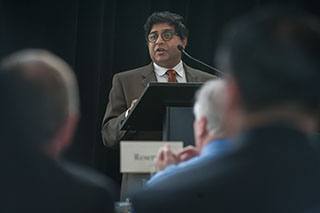
Dr. Sudeep Sarkar
The team applied the new technology to Tampa’s 2020 shutdown and found that the early months of the pandemic weren’t as problematic for local destinations like shopping mall - where occupancy was initially low, but then quickly rebounded - or locations in the downtown, where parking lot occupancy was the same as before the pandemic, Dr. Sarkar said. Meanwhile, other destinations saw an impact as more people worked from home and didn’t venture out for lunches or after-work socialization.
Dr. Sarkar said the satellite imagery can support analysts and policymakers' decision-making by providing a different kind of visibility into the unfolding economic changes not captured by other data sources. The analytics effort produces insights so quickly, a city can know if there programs are effective as they are rolling them out. After the team won a top prize from the European Space Agency in a COVID-19 monitoring challenge, the project was integrated into the agency’s data monitoring dashboard, he said. Their analysis early in 2021 showed European air traffic is still lagging, a sign of continuing economic trouble.
Read more about how the team is measuring economic activity from space in this case study.
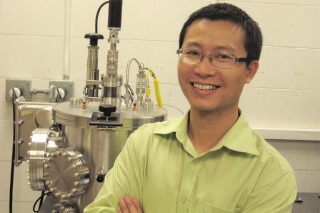
Dr. Manh-Huong Phan
Real-Time Monitoring of COVID-19 Progress Using Magnetic Sensing and Machine Learning
Principal Investigator: Dr. Manh-Huong Phan, Department of Physics, College of Arts and Sciences.
Co-PIs: Dr. Subhra Mohapatra, Morsani College of Medicine; Dr. Ehsan Sheybani, Muma College of Business.
The need to diagnose COVID-19 quickly and accurately, as well as to track its progress at various stages in real time, inspired a team led by Dr. Manh-Huong Phan to use of sensor technology along with medical analytics and modeling to develop an ultra-sensitive, contactless magnetic respiratory monitor capable of measuring the slightest changes in one of the major symptom of the disease – shortness of breath.
Each person has a unique breathing pattern in frequency and amplitude, Dr. Phan said. By analyzing breathing patterns, researchers can detect the difference between normal breathing and abnormal breathing caused by respiratory diseases.
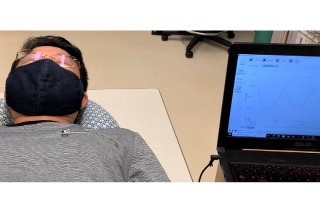
Dr. Phan demonstrates how a patient's breathing would be analyzed. Image courtesy of Dr. Manh-Huong Phan.
The newly developed monitor could provide crucial, real-time information to doctors on the growth of the virus in an infected patient and assist in clinical decision-making through the use of predictive analytics, Dr. Phan said.
The research team has filed for a U.S. patent on the new sensor technology. They are currently working with a health center to test the sensor system on people who have been diagnosed with COVID-19.
A model uses data collected from patients known to have different states of COVID-19 and applies machine learning to analyze the breathing patterns. The model also can determine the stage of COVID-19, the team said, which could help overloaded health care providers monitor and manage their patients’ more precisely.
The early development of the technology is “very promising”, and it may also have important applications in chronic pulmonary disease treatment and for sleep research, Dr. Phan added.
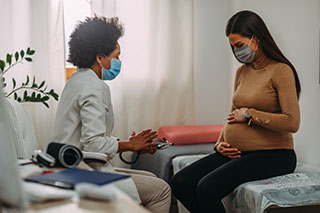
Exploring the Gut Microbiome in SARS-CoV-2 Infection Across Pregnancy
Principal Investigators: Dr. Maureen Groer, College of Nursing; and Dr. Tara Randis, Morsani College of Medicine.
Co-PIs: Dr. Larry Dishaw, Morsani College of Medicine; Dr. Adetola Louis-Jacques, Morsani College of Medicine; Dr. Daniel McSkimming, USF Health Office of Research; Dr. Stephanie Prescott, College of Nursing; and Dr. Jolan Walter, Morsani College of Medicine.
COVID-19 can create specific risks for pregnant women, especially those who do not have access to high-quality prenatal care. As researchers learn more about the role the gut microbiome plays in regulating immunity, the research team led by Dr. Maureen Groer of the College of Nursing and Dr. Tara Randis from the Morsani College of Medicine have sought to understand more about SARS-CoV-2’s effect on pregnant women and how the gut microbiome impacts the infection and inflammation in the mother’s body.
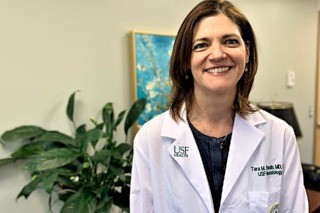
Dr. Tara Randis
The project enrolled 151 women of Hispanic heritage in their first trimester, focusing on that population because of the severe health care inequities the Latinx community experiences. Only a few had a previous diagnosis of COVID-19, with the vast majority not knowing if they had been exposed or infected. One third of the women were born in the U.S. and two-thirds either moved to Florida from Puerto Rico or immigrated from Latin American countries.
Thirty-seven percent of the women were positive for SARS-CoV-2, and most of them were asymptomatic, the team said. Asymptomatic infection among pregnant women has not been thoroughly studied, but the team is working toward documenting the differences in the gut microbiome between asymptomatic, symptomatic and COVID-19 negative women as well as how the birth outcomes for their infants differ. The team is also interested in following the asymptomatic women for signs of “long COVID”.
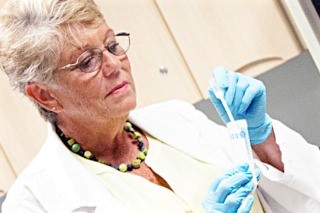
Dr. Maureen Groer
“We’re basically digging deep into the asymptomatic infection during pregnancy to understand if there are particular, important biological differences in women with asymptomatic infections,” Dr. Groer said.
The second track of the project is developing a preclinical model of an asymptomatic COVID-19 in pregnancy using a murine hepatitis virus that is similar, Dr. Randis said. The asymptomatic pregnant mice gained weight and had normal, healthy pregnancy and delivered healthy pups while the same virus in males and non-pregnant female mice caused significant weight loss. “The pregnancy-mediated finding is interesting in itself to us,” Dr. Randis said.

Relationships Between Air Quality, Health Outcomes, and Socioeconomic Impacts of the COVID-19 Pandemic in Florida
Principal Investigator: Dr. Yasin Elshorbany, School of Geosciences, College of Arts & Sciences.
Co-PIs: Dr. Steven Murawski, College of Marine Science; Dr. Heather O'Leary, Department of Anthropology, College of Arts and Sciences; and Dr. Marwa El-Sayed, Embry-Riddle Aeronautical University.
Community Partner: Lealman Innovation Academy.
The sudden stoppage of air travel, community and economic activity in many of the world’s developed countries in the early months of the COVID-19 sweeping around the world presented a cross-disciplinary team an unique opportunity to examine the relationships between air quality, health outcomes and socioeconomic impacts of the pandemic. In many ways, the shutdown became a glimpse into whether the planet could recover from environmental damage done by economic activity quickly.
Led by Dr. Yasin Elshorbany, an assistant professor of atmospheric chemistry and climate change at USF’s St. Petersburg campus, was published in the Journal of Remote Sensing. The team analyzed the impact of the pandemic-related lockdown on air quality by using remote sensors that measured different elements within the air, including nitrogen dioxide, carbon monoxide, ozone and aerosol particles. The study focused on states with high traffic volume, such as New York, Illinois, Florida, Texas and California.
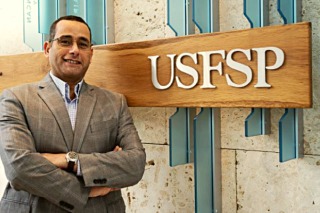
Dr. Yasin Elshorbany
The researchers found dramatic decreases in traffic caused by COVID-19 shutdowns improved air quality in car-dependent states, but did such as Florida, but the shut down didn’t offset additional forms of pollution in other parts of the country where pollution is brought on by coal plants and industrial factories.
The study found that vehicle volumes across the U.S. dropped by 40-60 percent shortly after the pandemic was declared.
The team joined with Duke Energy and the Lealman Innovation Academy to further examine key environmental impacts brought about by the coronavirus lockdown, aiming to better understand the health and socioeconomic consequences of changes in air quality. Duke Energy provided the researchers with data about energy consumption patterns before and during the pandemic and the students assisted USF Anthropology Assistant Professor Heather O'Leary's EcoFem Lab in collecting and interpreting environmental data from Pinellas county.
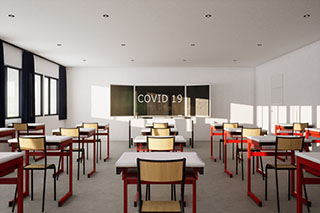
Mathematics and Science Teaching and Learning of COVID-19 Public Health Issues in eLearning Environments
Principal Investigator: Dr. Allan Feldman, College of Education.
Co-PIs: Dr. Marissa Levine, College of Public Health; David Rosengrant, College of Education; Dr. Sarah Van Ingen Lauer, College of Education; Dr. Eugenia Vomvoridi-Ivanovic, College of Education; Matthew O’Brien, PhD student, College of Education; Jawaher Alsultan, PhD student, College of Education; and Dr. Irem Ercan, College of Education.
The research team worked with Hillsborough County Public School middle school math and science teachers to develop methods and materials for students to learn about the COVID-19 pandemic. Seventh-grade teachers from four Title 1 schools worked collaboratively to develop a curriculum which demonstrated how mathematicians and scientists worked with public health experts to track and report the spread of the pandemic. The lessons helped explain to students some of the measures - such as per capita infection rates and positivity rates – that have become a daily fixture in how the public tracks the pandemic.
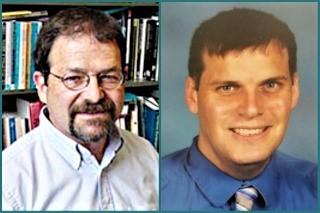
Dr. Allan Feldman and USF Education PhD student Matthew O'Brien
The teachers joined with USF researchers in a summer 2020 workshop and developed the curriculum materials to align with state standards, while also providing students with a rare opportunity to understand those concepts as they affected their daily lives and in real time. The overarching goal of the project was to help students learn to think in terms of interconnected systems, appreciate the dynamic nature of such events, and show how mathematics can help lead decision making amidst a crisis, said College of Education PhD student Matthew O’Brien.
“Student engagement increased during the lessons on COVID because the content was related to daily life,” he said. “The real-world content provided students with better understand of ratios and proportions, as well as infectious diseases.”
The USF team also was interested in how the inequalities of the e-learning environment affected teaching and learning of the content due to technology issues, language barriers, and home environments that made learning difficult. The teachers shared their experiences with their colleagues in a May 2021 webinar, “Making Math & Science Real”.
The USF team is going to further study the implementation of the lessons next fall to help students understand their post-pandemic world, O’Brien said.
Watch the webinar Making Math and Science Real here.
